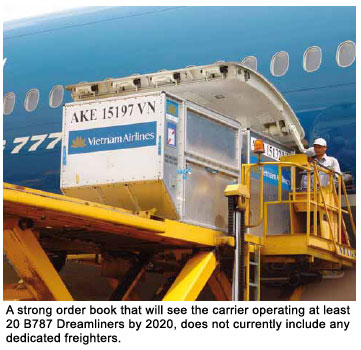
When 2007 comes to a close, Vietnam Airlines will have surely have clocked in another rosy year. In the first nine months, its 47,297 domestic and international flights have carried over 5.8 million passengers, achieving 76 per cent of the year’s target, and over 82,000 tonnes of cargo (an increase of 5.6 percent year-on-year).
Not only did its pretax profits surge to US$18.8 million – nearly matching the whole profit of US$19 million for the full year, last year, but its on-time performance rate increased to 82 per cent. But cloudy skies may be liking just ahead.
As the airline pushes ahead with its aggressive expansion plans, its top management could not be busier. In Hanoi, Vietnam Airlines’ deputy general director Pham Ngoc Minh is now also the chairman of the newly-established Vietnam Aircraft Leasing Company.
On his desk are also the plans for equitization of the carrier, slated to be realised some time in 2008. With a registered capital of 5.74 trillion Vietnamese dong (US$358.75 million) the carriers will go public once its 39 affiliates are collected together under the form of a new holding company.
Add to this the impending move to full e-ticket operations and a plan for fi ve weekly direct flights to the US West Coast ¨C Los Angeles ¨C using 777- 200ERs, to be started by late 2008, and that makes Pham a very difficult man to get a hold of.
Pressure from the low-cost sector
There are also rumours in the industry that in order to fend off competition from home and abroad, particularly the low-cost segment, Vietnam Airlines will turn its subsidiary Vietnam Air Services Company (Vasco) into a nofrill carrier.

This competition includes the Ho Chi Minh City-based, low-cost carrier Pacific Airlines, which now enjoys the financial backing of Qantas, along with other emerging adversaries, like the joint venture formed between Malaysia low-cost carrier AirAsia and Vietnam’s shipbuilding expert Vinashin, or recently established VietJet Aviation, Vietnam’s fourth but very first private airline.
Critical pilot shortage
In Ho Chi Minh City, near Tan Son Nhat International Airport, Nguyen The Trung, director of Vietnam Airlines’ Flight Training Center, is also very busy. A captain in his early fifties, he still has to be in the cockpit a few times a week for international commercial flightsbecause of a critical pilot shortage.
From 1996 to 2006, Vietnam Airlines was able to select 215 potential pilots for training of which 184 eventually became pilots. It means that each year the carrier can provide only 18.4 pilots on a demand of 50, which is expected to increase to 80 pilots/year by 2017. Now, it has to hire foreign captains, costing on average US$20-30 million per year.
Fast expanding, the carrier has a serious challenge to face, in light of both pilot shortage and aircraft shortage. Flight delays and cancellations have made Vietnam Air the subject of continuous rapping from the local media and while waiting for the new bunch of cadets to begin flying, it has to rely on "outsourcing" pilots from Europe and the US.
"IATA has decided, we, already a member of that organisation, just have to follow its decision," regarding the issue of allowing pilots to fly until 65 years-of-age, said Pham Quy Tieu, a top official from the Civil Aviation Administration of Vietnam.
Foreign cargo giants move in
While the country’s national flag-carrier still appears reluctant to enter the air cargo market, many other foreign freighter operators have increased their activities at its own home-base.
CargoItalia started flying into Tan Son Nhat International Airport in May. It was soon followed by Cargolux in late October with a twice weekly flight ferrying goods to Bangkok and Hong Kong.
Beginning November, it was Singapore Airlines Cargo’s turn with a new once a week flight linking Singapore with Hanoi and Shanghai. All those heavyweights are using large aircraft like the Boeing 747-400F and MD- 11F.
"About 70 per cent of the total volume of goods air transported from Vietnam are garments, shoes, handicrafts and their destinations are mainly European cities," said Vinh Bao, a former KLM Cargo manager.
Some 20 per cent of cargo, mainly perishable goods, are carried to cities in the Asia-Pacific region such as Tokyo, Seoul, Beijing, Shanghai, Singapore, Bangkok, Sydney and Melbourne and the remaining 10 per cent to cities in Africa, especially to Johannesburg, Cape Town and Durban in South Africa.

"To see all those loads flying out on foreign carriers makes my heart sink. I hope that Vietnam Airlines will rethink its policy," Bao said.
Dedicated freighters are now fl own into Vietnam – ranging between once and fi ve-times a week – by Air France Cargo, Cargolux, CargoItalia, China Airlines, EVA Air, DHL, Japan Airlines, Korean Air, Shanghai Airlines and Singapore Airlines Cargo.
But it looks like Vietnam Airlines’ flight path has already been decided, at least until 2020, since in its most recent spate of aircraft buying, there was no mention of any freighter.
A slew of recent aircraft orders
In the rush to fly ahead of the, now growing, strong pack of competitors, as well as to meet the demands of ever increasing domestic and international air travel (now growing at rate of 11.7 per cent a year by 2020), Vietnam Airlines has a slew of aircraft orders.

This includes, from late-September, orders for four more B787s from Boeing and signed a memorandum of understanding for the purchase of 20-A321s and 10-A350-900 XWBs from Airbus. Meanwhile it will also lease 8 other 787s that Vietnam Aircraft Leasing Company (VALC) has ordered.
With the four previously ordered B787s ¨C to be delivered in 2009 and 2010 ¨C Vietnam Airlines intends to operate a fleet of 20 Dreamliners by 2015, rising to 28 by 2020.
By that time, its entire fleet will comprise of 107 aircraft, of which 50 are of the A320 family of aircraft. "Of course the belly of these new aircraft can accommodate lots of pallets but the real source of profits are still the fully heavylift freighters, but our national carrier still thinks that caring for passengers is more important," Bao said.
In Hanoi, the top management of Vietnam Airlines is also busy developing a strategy for "fighting" against the rush of foreign airlines coming in. In 2007 alone, there have been Qatar Airways, UNI Air, Hong Kong Airlines, Mandarin Airlines, Nok Air and Viva Macau all staging new and/or additional flights into Vietnam.
In Ho Chi Minh City, captain Trung is thinking of the day when there will be even greater need for pilots flying the Airbus and the Boeing jets now on order.









